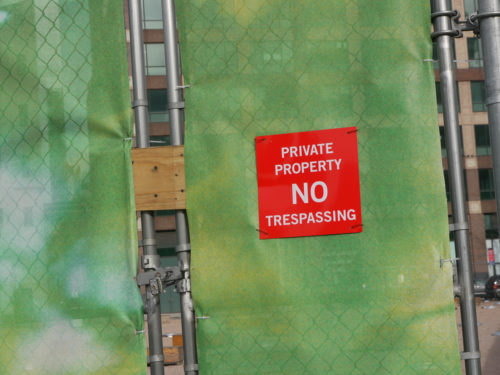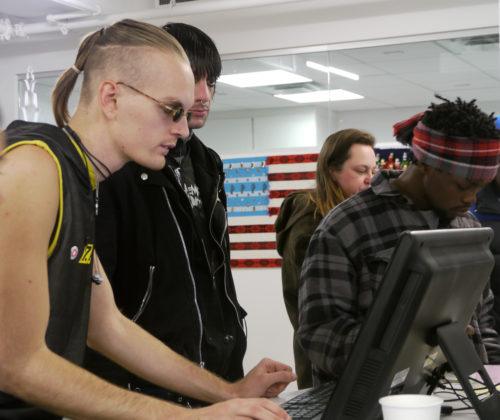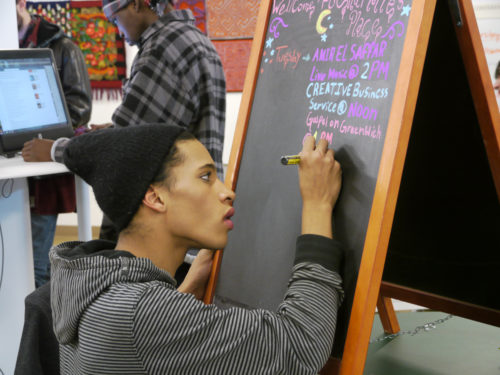Use of Trinity property becomes the focus of Occupy Wall StreetPosted Dec 15, 2011 |
|
[Episcopal News Service] A sliver of property owned by Trinity Episcopal Church, Wall Street, located at Canal Street and Sixth Avenue adjacent to Duarte Square in lower Manhattan has become the focal point of Occupy Wall Street as the movement against greed and economic inequality enters its third month.
“If the movement is about economic equity, social justice, proper interaction against civilized folks, that message can be conveyed in a variety of ways without occupying someone else’s property,” said the Rev. Jim Cooper, Trinity‘s rector, in an interview with ENS Dec. 12, reinforcing his Dec. 9 statement posted on Trinity’s website. Since early in the movement, Trinity has provided meeting space and use of its facilities, when open, for bathrooms and respite to OWS but has held firm on not allowing occupiers on the Duarte Square property.
Occupiers were evicted from Zuccotti Park, a privately owned public park two blocks north of Trinity on Broadway in the financial district, in the early morning hours of Nov. 15 and they can no longer continue camping there overnight. Since then, OWS has maintained that it needs space to “occupy” to build its community and carry the movement forward.
Occupy Faith NYC, an interfaith coalition formed in the wake of the OWS movement; Bishop George Packard, retired Episcopal bishop for the armed forces and federal ministries; and others have pressured the church to allow OWS to use its property as a new base of operations. More than 11,000 people have signed a Faithful America petition asking Trinity to offer sanctuary to OWS.
According to the current plan, occupiers and their supporters will converge on Duarte Square at noon Dec. 17 for “Occupy 2.0: Take Back the Commons,” an all-day performance event in support of OWS and “the occupation of space and reclaiming of the commons.”
“There is a plan to occupy the space owned by the church,” Linnea Palmer Paton, a 23-year-old New York University student and member of the OWS public affairs working group, said in a Dec. 14 telephone interview. But a final decision will not be made until the 17th, she said.
The Dec. 17 date coincides with the three-month anniversary of OWS’ formal launch at Zuccotti Park. It also marks the birthday of U.S. Army Pfc. Bradley Manning, facing a Dec. 16 court martial at Fort Meade in Maryland for allegedly passing classified military information to the website WikiLeaks; and the one-year anniversary of the self-immolation of Tunisian street vendor Mohamed Bouazizi, the act that sparked the Arab Spring, the independent, democratic uprisings that spread across the Arab world in 2011 and inspired the Occupy movement.
OWS protests have spread to more than 2,500 locations across the country and around the world. In the last month, officials in many cities have moved to dismantle protest encampments. The movement calls on displaced occupations across the nation to reoccupy outdoor places on the 17th.
 A sign tacked to the chain-linked fence’s padlocked entrance at the Trinity-owned property reads: “private property no trespassing.” Through the fence one can see a dozen or so wooden benches and a few wooden planters. Tiny pebbles cover the ground. Trinity leases the property to the Lower Manhattan Cultural Council, which uses it seasonally for outdoor art exhibitions and cultural events.
A sign tacked to the chain-linked fence’s padlocked entrance at the Trinity-owned property reads: “private property no trespassing.” Through the fence one can see a dozen or so wooden benches and a few wooden planters. Tiny pebbles cover the ground. Trinity leases the property to the Lower Manhattan Cultural Council, which uses it seasonally for outdoor art exhibitions and cultural events.
It’s the “totality of issues” – legal, health, safety, land use, being a good neighbor – “that when we add up all of them Trinity sees the request for an encampment or large assemblies as an inappropriate use of that land,” said Cooper during the Dec. 12 interview at Charlotte’s Place, a church-owned and operated community gathering place on Greenwich Street just south of Zuccotti Park.
“And there’s the fine line of politics and [the] spiritual, and we’re of a spiritual focus,” he said. “I don’t know how Occupy Wall Street would define itself.”
It took 12 months of negotiation with the city of New York before Trinity could lease the property, which is near the entrance to the Holland Tunnel and lacks basic water and sanitary services, to the LMCC, Cooper said. He and the church’s vestry and wardens review and consider lease agreements, Cooper said.
On Dec. 3, three OWS participants staging an overnight protest and hunger strike aimed at pressuring the church to let the Occupy movement set up camp on its property were arrested. They were released the following day. Previously, protesters who entered the Trinity property on Nov. 15 had been arrested.
Late in the night on Dec. 10 in Duarte Square, Cooper and his wife, Octavia, met with the three hunger strikers who had by then been joined by a fourth. The hunger strikers then attended the 9 a.m. Eucharist at Trinity the next morning, along with Packard and his wife, Brook.
During his sermon, Cooper talked about prophecy, law and order, and the long-lasting, shared bonds formed in challenging, hard times.
“Every generation has hard times, and sometimes really hard times,” said Cooper, referencing lyrics from a Neil Diamond song, in a sermon repeated at the 11:15 a.m. Eucharist.
Packard has been vocal in his support of OWS even while he has been doing what he called “reluctant shuttle diplomacy between the Occupiers and Trinity Church.”
“I have this great worry that this venerable parish will be on the wrong side of history in a few weeks,” Packard said in a post on Trinity’s Facebook page that later was deleted. “Surely there’s some consummate wisdom in the leadership that can offer Occupiers a chance to express their prophetic destiny in these days. It’s a matter of record that the church is good with the provision of service and succor for the neighborhood; they are unable, it seems, to understand their dynamic needs. Plainly said, this means looking afresh at lease arrangements for a season regarding the Duarte property. Think of it as offering hospitality to travelers from our future who bring the message of ‘no injustice, no more.’ If we really saw OWS for who they are rather than putting up roadblocks in their path, we’d truly delight in their coming!”
On his blog “Occupied Bishop,” Packard later called his posting to Trinity’s Facebook page “a fit of pique” but asked: “Wouldn’t this kind of conversation be active in the parish?”
OWS describes itself as a “leaderless resistance movement.” Despite the absence of a permanent camp, it has continued to organize work groups to focus on particular issues and to meet in “general assemblies” in locations across the city.
Trinity and OWS “use two different kinds of vocabulary” and Occupy looks at “property” from a totally different point of view, Packard said in a Dec. 14 telephone interview with ENS.
“They [OWS] believe in liberating property as part of their core belief,” he said.
The movement views the occupation of outdoor space as a “symbol of direct action,” as explained in the December 2011 issue of “Tidal,” a journal of occupation theory published by Occupied Media.
The Episcopal Church, through direct involvement and support offered by clergy and laity and through the use of its churches and buildings, has supported OWS from the beginning.
The Executive Council at its October meeting passed a resolution (AN037) affirming “the growing movement of peaceful protests in public spaces in the United States and throughout the world in resistance to the exploitation of people for profit or power bears faithful witness in the tradition of Jesus to the sinful inequities in society” and calling upon Episcopalians “to witness in the tradition of Jesus to inequities in society.”
In Boston, for example, Episcopalians were among a group of Protest Chaplains who maintained a faith and spirituality tent for occupiers of a downtown encampment. Following the close of their Dewey Square encampment, the Diocese of Massachusetts’ Cathedral Church of St. Paul began offering Occupy Boston protesters meeting space for their general assemblies, “through which local Occupy participants come to consensus about future actions,” starting Dec. 13, according to a statement on the diocesan website.
The cathedral “has offered to host the meetings on a week-to-week basis, as needed, and is doing so not to endorse a particular point of view but instead ‘to endorse the conversation,’ according to the cathedral’s dean, the Very Rev. Jep Streit,” the statement said.
Streit said in the release that “the issues raised by the Occupy movement are important to be discussing in society, and so I’m happy to offer our cathedral to provide hospitality and a venue so those conversations can continue.” He noted that he felt that “attention had of late shifted to controversy over the protesters’ encampment and away from the economic and social justice issues at hand.”
In Chicago, where protestors are required to remain mobile, Grace Episcopal Church has provided food and sleeping space for movement leaders.
“The desire represented by Occupy Wall Street for a restoration of fairness and equity in our society is one with which I am wholly in sympathy, and which all Christians should support — and I think we should note that Trinity Church has been strongly supportive of OWS from its beginning,” Diocese of New York Bishop Mark S. Sisk said in a Dec. 13 statement e-mailed to ENS.
“But one typical feature of movements for change is their tendency to see situations in black and white: You are either for them, or against them,” he wrote. “This is the dynamic that is, I’m afraid, prevailing with regard to the Duarte property — and a great deal of heat and plenty of smoke are being generated by it. Whether Trinity’s legal obligation to its existing tenant is outweighed by its obligation to a vision of justice as represented by OWS is a question to which there may be no entirely satisfactory answer; it is certainly one on which, I believe, people of goodwill can reasonably disagree. ”
Besides attracting occupiers, activists, supporters and tourists, the encampment at Zuccotti Park became a magnet for homeless people and LGBT runaways, who pitched tents and received food and medical attention. Throughout the occupation, Trinity made Charlotte’s Place available as a safe haven for occupiers: a place where people could take a break from the often crowded, media-frenzied atmosphere of the park.
During the period immediately following the Nov. 15 early-morning raid when, on the order of New York Mayor Michael Bloomberg, the New York Police Department cleared the park and arrested some 200 occupiers, Charlotte’s Place, which is open from noon to 6 p.m. weekdays, continued to serve the protesters, and for a short time bent the rules and allow people to sleep in the space.
On Nov. 16, Archbishop Bernard Ntahoturi of the Anglican Church of Burundi, a country emerging from a 12-year, ethnic-based civil war, visited Trinity and spoke about reconciliation with the displaced occupiers gathered at Charlotte’s Place.
Charlotte’s Place continues to host between 150 and 200 people daily, most of them occupiers, half of them homeless, said Jennifer Chinn, program manager, who added that she had remained neutral regarding OWS, staying focused on Charlotte’s Place’s mission.
“It’s not about ideology; it’s about the welcome and hospitality. It’s not always easy. Being welcoming feels like a challenge, and that’s when you know it is working,” she said. At times, she said, occupiers have used the meeting space to organize against Trinity and have asked her, from a personal standpoint, “‘Are we OK?'”
Recognizing the need for social, homeless and medical services, Trinity hired the Rev. Mary Caliendo, a Wiccan priest who works with Occupy’s medical clinic — which includes doctors, nurses and psychiatrists aiding protestors — to work at Charlotte’s Place and facilitate care.
Once word spread of free food and medical services, people started showing up, Caliendo said.
Displaced protestors include people like Michael Morgan. Originally from Philadelphia, Morgan, 42, lived on the streets of New York for two years. He and his girlfriend, Seida Safford, 24, who is pregnant, lived in a tent at Zuccotti Park and now are spending nights in churches. At least two United Methodist churches — one in Park Slope, Brooklyn, and another on Manhattan’s Upper West Side — continue to shelter homeless people evicted from Zuccotti.
Morgan and Safford have become part of Occupy’s homeless working group, trying to help other homeless people access the services they need, he said during a Dec. 12 interview with ENS at Charlotte’s Place.
Without an encampment, Morgan said, he feels isolated from the movement.
Also at Charlotte’s Place on Dec. 12 was Sonya Zink, 40, who owns a home in Park Falls, Wisconsin, a town with a population of 2,000. She was laid off from a job in social services in 2009, worked on the U.S. Census in 2010, but now remains unemployed, as do close to 10 percent of the residents of her hometown.
Zink began following the movement back in April when it was chatter on Twitter that began to build and manifested as the U.S. Day of Rage on Sept. 17, the birth of the Occupy movement.
Like many others, she said, she is angry that the U.S. government “is refusing to represent its people.”
The park was almost a perfect microcosm for the racism, classism and entitlement present in society — all of the corruption OWS is attacking, “manifested in our movement,” said Zink, adding that her focus is to bring the voices of the marginalized to the table.
Despite their eviction, OWS protesters continue to protest, but not sleep, in Zuccotti Park, which is surrounded by metal parade barriers and guarded 24 hours a day by a private security firm.
Zink typically takes the overnight shift in the park, she said.
OWS doesn’t intend to recreate the original encampment in Duarte Park and has learned from its past mistakes, said Paton, the OWS spokesperson.
“The idea is to have it better run than the last occupation,” she said. “People can’t just come to crash; they’d have to contribute. And because it would be a gated, 24-hour operation where people would be living on the site — not permanent living, but sleeping space, not covered by tents — it would be focused.”
In a 23-page-outline, including a computer-generated rendering of what the three-quarter-acre encampment could look like, including open space, meeting space, tents, a kitchen and sanitation/toilets, OWS has created a statement of intention and a list of community agreements – which prohibits the use of drugs or alcohol in the space.
“We understand that the church has some concerns related to health and safety,” said Paton. The movement has a plan to address those issues, she said, adding that the more immediate concern is one of free speech and seeking Trinity’s support of the fight for justice by offering a space that otherwise is a vacant lot.
On Dec. 15, religious leaders and OWS activists placed a “guerilla nativity,” in front of Trinity. The scene, which activists called a “peace offering,” featured Joseph, Mary, and Jesus inside an OWS tent that was inscribed with “Luke 2:7 ‘There was no room for them in the inn,’ but with $10 billion in real estate, Trinity has plenty of room.”
The church owns 16 acres of land in the Hudson Square neighborhood and holds 6 million square feet of office space in its real-estate portfolio, making it one of the largest landholders in Manhattan. Its holdings help fund its outreach work both locally and around the world.
— Lynette Wilson is an editor/reporter for Episcopal News Service. ENS correspondent Sharon Sheridan contributed to this article.



Social Menu